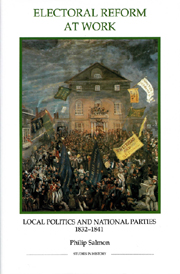Introduction
Published online by Cambridge University Press: 12 September 2012
Summary
This book is about the political modernisation of Britain that resulted from the ‘Great’ Reform Act of 1832. It argues that this extensively debated parliamentary reform moved the nation far closer to a modern type of electoral system than has previously been supposed, and that this happened in two principal ways. First, this study explains how the Reform Act's curiously neglected practical provisions, far from being mere ‘small print’, as has often been assumed, transformed the business of obtaining the vote and led to the emergence of new forms of party organisation and voter partisanship after 1832. Second, it demonstrates how the Reform Act's long overlooked constitutional interaction with other institutions of early nineteenth-century government, most notably the parish vestry, the board of guardians and the municipal corporation, caused new types of nationally-oriented party structures to multiply through all levels of British politics, so laying the foundations for the representative democracy of the Victorian era.
Such a work is long overdue. Charles Seymour's classic account of the operation of the early Victorian representative system dates from 1915 and Norman Gash's rather different kind of study, which was primarily concerned with the persistence of electoral corruption and control, from 1953. New archive collections and analytical techniques, including the rise of a whole new discipline of psephology, would alone make a fresh investigation of this subject necessary, but this book also has a further imperative behind it.
- Type
- Chapter
- Information
- Electoral Reform at WorkLocal Politics and National Parties, 1832–1841, pp. 1 - 16Publisher: Boydell & BrewerPrint publication year: 2002

